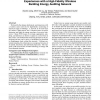Free Online Productivity Tools
i2Speak
i2Symbol
i2OCR
iTex2Img
iWeb2Print
iWeb2Shot
i2Type
iPdf2Split
iPdf2Merge
i2Bopomofo
i2Arabic
i2Style
i2Image
i2PDF
iLatex2Rtf
Sci2ools
95
Voted
SENSYS
2009
ACM
2009
ACM
Experiences with a high-fidelity wireless building energy auditing network
We describe the design, deployment, and experience with a wireless sensor network for high-fidelity monitoring of electrical usage in buildings. A network of 38 mote-class AC meters, 6 light sensors, and 1 vibration sensor is used to determine and audit the energy envelope of an active laboratory. Classic WSN issues of coverage, aggregation, sampling, and inference are shown to appear in a novel form in this context. The fundamental structuring principle is the underlying load tree, and a variety of techniques are described to disambiguate loads within this structure. Utilizing contextual metadata, this information is recomposed in terms of its spatial, functional, and individual projections. This suggests a path to broad use of WSN technology in energy and environmental domains. Categories and Subject Descriptors H.4 [Information Systems Applications]: General; B.4 [Input/Output and Data Communications]: General General Terms Design, Experimentation, Measurement, Performance, Human ...
Related Content
| Added | 19 May 2010 |
| Updated | 19 May 2010 |
| Type | Conference |
| Year | 2009 |
| Where | SENSYS |
| Authors | Xiaofan Jiang, Minh Van Ly, Jay Taneja, Prabal Dutta, David E. Culler |
Comments (0)

